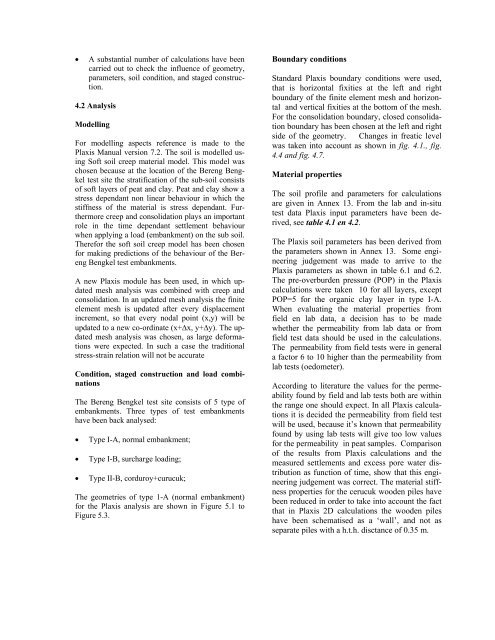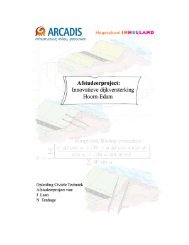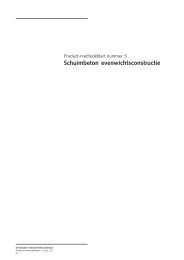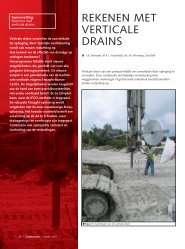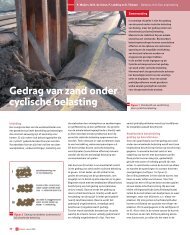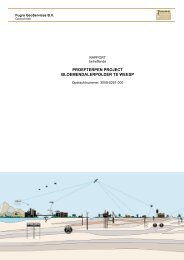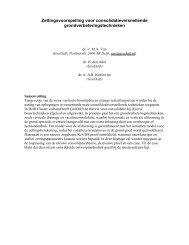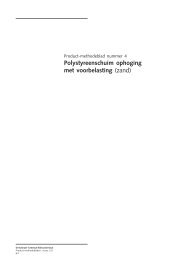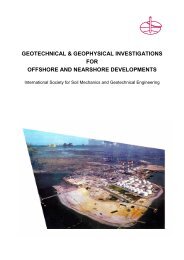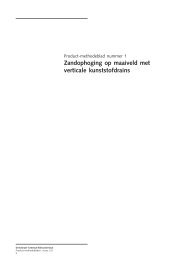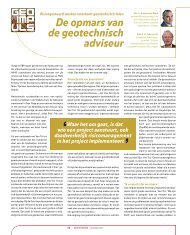THE BERENG BENGKEL TRIAL EMBANKMENT
THE BERENG BENGKEL TRIAL EMBANKMENT
THE BERENG BENGKEL TRIAL EMBANKMENT
Create successful ePaper yourself
Turn your PDF publications into a flip-book with our unique Google optimized e-Paper software.
• A substantial number of calculations have been<br />
carried out to check the influence of geometry,<br />
parameters, soil condition, and staged construction.<br />
4.2 Analysis<br />
Modelling<br />
For modelling aspects reference is made to the<br />
Plaxis Manual version 7.2. The soil is modelled using<br />
Soft soil creep material model. This model was<br />
chosen because at the location of the Bereng Bengkel<br />
test site the stratification of the sub-soil consists<br />
of soft layers of peat and clay. Peat and clay show a<br />
stress dependant non linear behaviour in which the<br />
stiffness of the material is stress dependant. Furthermore<br />
creep and consolidation plays an important<br />
role in the time dependant settlement behaviour<br />
when applying a load (embankment) on the sub soil.<br />
Therefor the soft soil creep model has been chosen<br />
for making predictions of the behaviour of the Bereng<br />
Bengkel test embankments.<br />
A new Plaxis module has been used, in which updated<br />
mesh analysis was combined with creep and<br />
consolidation. In an updated mesh analysis the finite<br />
element mesh is updated after every displacement<br />
increment, so that every nodal point (x,y) will be<br />
updated to a new co-ordinate (x+∆x, y+∆y). The updated<br />
mesh analysis was chosen, as large deformations<br />
were expected. In such a case the traditional<br />
stress-strain relation will not be accurate<br />
Condition, staged construction and load combinations<br />
The Bereng Bengkel test site consists of 5 type of<br />
embankments. Three types of test embankments<br />
have been back analysed:<br />
• Type I-A, normal embankment;<br />
• Type I-B, surcharge loading;<br />
• Type II-B, corduroy+curucuk;<br />
The geometries of type 1-A (normal embankment)<br />
for the Plaxis analysis are shown in Figure 5.1 to<br />
Figure 5.3.<br />
Boundary conditions<br />
Standard Plaxis boundary conditions were used,<br />
that is horizontal fixities at the left and right<br />
boundary of the finite element mesh and horizontal<br />
and vertical fixities at the bottom of the mesh.<br />
For the consolidation boundary, closed consolidation<br />
boundary has been chosen at the left and right<br />
side of the geometry. Changes in freatic level<br />
was taken into account as shown in fig. 4.1., fig.<br />
4.4 and fig. 4.7.<br />
Material properties<br />
The soil profile and parameters for calculations<br />
are given in Annex 13. From the lab and in-situ<br />
test data Plaxis input parameters have been derived,<br />
see table 4.1 en 4.2.<br />
The Plaxis soil parameters has been derived from<br />
the parameters shown in Annex 13. Some engineering<br />
judgement was made to arrive to the<br />
Plaxis parameters as shown in table 6.1 and 6.2.<br />
The pre-overburden pressure (POP) in the Plaxis<br />
calculations were taken 10 for all layers, except<br />
POP=5 for the organic clay layer in type I-A.<br />
When evaluating the material properties from<br />
field en lab data, a decision has to be made<br />
whether the permeability from lab data or from<br />
field test data should be used in the calculations.<br />
The permeability from field tests were in general<br />
a factor 6 to 10 higher than the permeability from<br />
lab tests (oedometer).<br />
According to literature the values for the permeability<br />
found by field and lab tests both are within<br />
the range one should expect. In all Plaxis calculations<br />
it is decided the permeability from field test<br />
will be used, because it’s known that permeability<br />
found by using lab tests will give too low values<br />
for the permeability in peat samples. Comparison<br />
of the results from Plaxis calculations and the<br />
measured settlements and excess pore water distribution<br />
as function of time, show that this engineering<br />
judgement was correct. The material stiffness<br />
properties for the cerucuk wooden piles have<br />
been reduced in order to take into account the fact<br />
that in Plaxis 2D calculations the wooden piles<br />
have been schematised as a ‘wall’, and not as<br />
separate piles with a h.t.h. disctance of 0.35 m.


